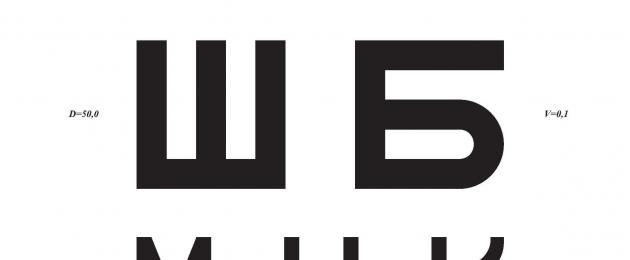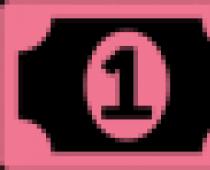It is necessary to perform an eye examination procedure each time you enter a school, apply for a job, undergo a medical commission for a military registration or enlistment office or get a driver's license.
Visual acuity is called the ability of the eye to distinguish 2 points located at some distance from each other (even the minimum). According to the existing norm, an eye with 100% vision is able to distinguish two distant points when the angular distance between them is 1 minute (i.e., 1/60 degree).
Simply put, visual acuity is a qualitative indicator of the vigilance of the eyes, allowing you to measure how clearly a person sees. The norm adopted visual acuity equal to 1.0 (100%). It is determined by special tables with optotypes. In Russia, the most common table for testing Golovin-Sivtsev (or Sivtsev's table).
A person’s visual acuity may be more than normal, for example, 1.2 and 1.5, and 3.0 or even more. But in the case of refractive errors (myopia, hyperopia), astigmatism, cataracts, glaucoma, etc., visual acuity falls below the norm, for example - 0.8 and 0.4, and 0.05, and so on.
There are attempts to translate visual acuity in the percentage. However, it should be remembered that simply converting this indicator to percentages is somewhat incorrect. In such a recalculation there are a lot of difficulties, since it is necessary to take into account many parameters that determine the quality of vision. Therefore, although 1.0 is considered to be 100% vision, but a vision of 0.2 diopters is not at all 20%, but 49% of the norm. Thus, it is not possible to convert any visual acuity indicators other than one into percentages.
Sivtsev's table is a standard set of letters (typed characters) designed to determine the value of human visual acuity. Seven different letters in the table are randomly repeated and have a different size, decreasing from the top rows to the bottom. The proposed table is designed to determine visual acuity from a distance of 5 m, in the range of 0.1 - 5.0D. The first 10 rows of it (with V = 0.1–1.0) are executed with a step of 0.1, two rows following (V = 1.5–2.0) are followed with a step of 0.5, and the additional three rows (V = 3.0–5.0) - with a step of 1.0.
How to conduct research
For the procedure of determining visual acuity, the test table is placed at a distance of 5 m from the subject's eyes. At the same time, it should be illuminated with one incandescent lamp or two fluorescent ones, so that the illumination is 700 lux. The light of the lamp (s) is directed to the table so that it does not hit the person in the face.
The vision test table is a familiar oculist table that allows us to evaluate the sharpness of our vision.
After printing this table and fixing it on the wall, we will be able to prevent sharpness from falling, as well as monitor progress in restoring vision in real time. And if we use, then progress will not take long.
So, my friends, before you is Sivtsev's table, which is widely used to check the vision of oculists.
The table with letters consists of 3 parts: this separation is necessary for convenience, so that we can print it in A4 format.
After downloading and printing these 3 sheets, we will glue them together and that's it, the table for checking the vision in the original size is ready.
How to download and print?
Click on the pictures to increase them to the original size, then download the table to test the vision from 3 parts to your computer.
The format for printing should be A4, and the orientation in the settings you need to select the landscape.
After printing 3 sheets, join them together with scotch tape, buttons or glue. Done!
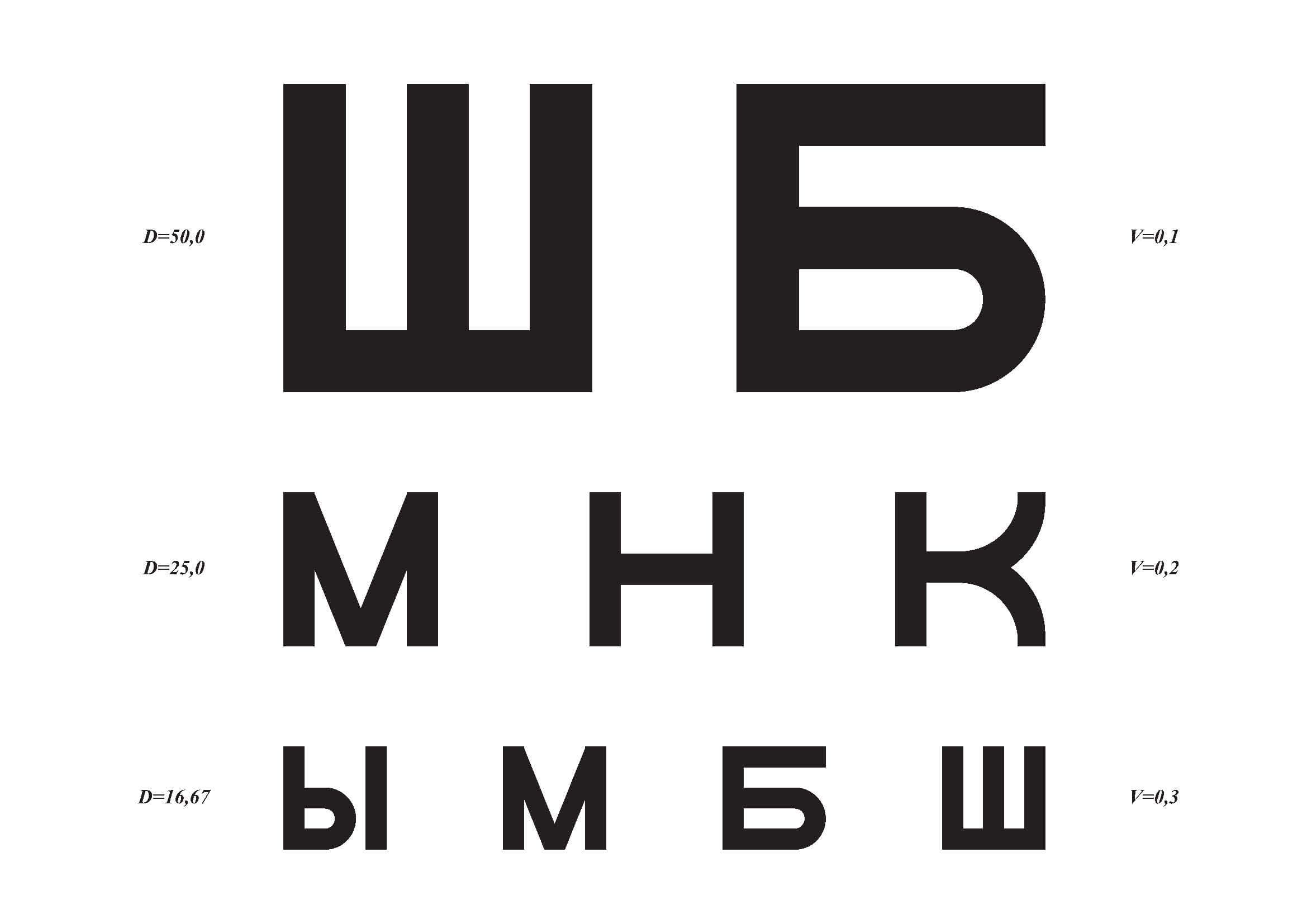

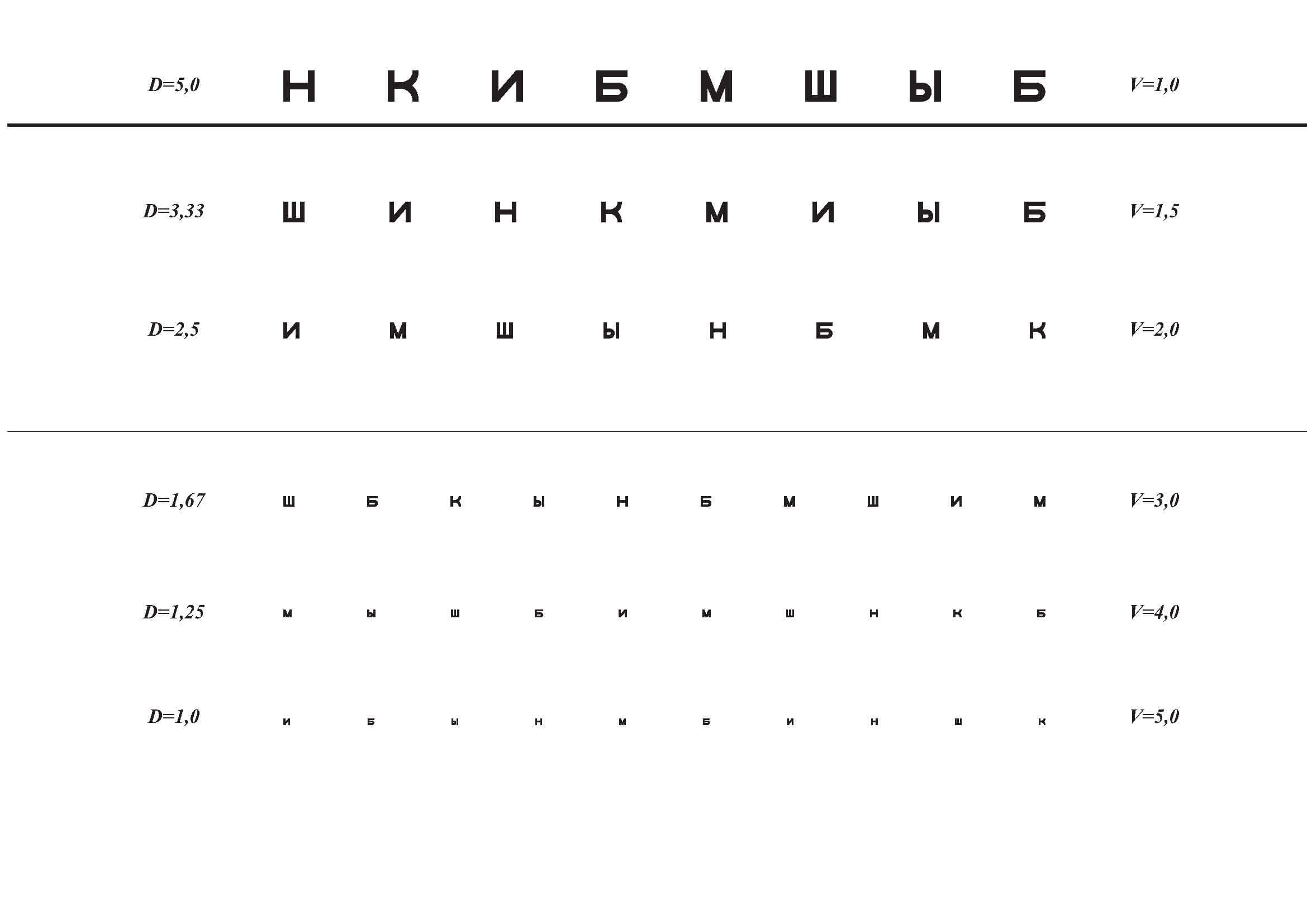
How to check your eyesight at home? Fix the table on the wall (at eye level). The distance from you to the table should be 5 meters, the table itself should be illuminated by the sun or a lamp. When these conditions are met, proceed directly to checking visual acuity.
Each eye is checked separately: one is covered with the palm of the hand, the other is read the letters. Covered eye does not need to close.
Unfortunately, it is impossible to determine the diopter with the help of the table for eye examination, for this requires special lenses. And no one guarantees the right 100% accuracy - it can be obtained only with a professional examination from an ophthalmologist. But to test the vision at home, the result is quite accurate.
In general, the proposed table for eye examination copes with the task ahead of us - eye testing. It is very convenient to observe the return of the vigilance of our eyes when performing. For example, comparing the results for the past and current months. Even when the vision becomes better only by one line, it’s such a joy — beyond words. Yes, and additional motivation appears when you see the results of their work. So, without doubt, download and print a table - this is a simple and convenient way to test your eyesight at home.
More by topic:
16 exercises for a clear and clear view The main rule of conservation of vision 49 pictures to improve vision
Every person is faced with the need for eye examination. This is necessary when entering a school or a new place of work, when passing a medical commission or medical examination. Serve as a reason to visit the oculist may be pathological disorders of the organs of the visual system. In most cases, ophthalmologists use special tables for diagnosis. Automated devices can also be used. It is usual for patients when they use a table for checking visual acuity, on which letters of the alphabet are written in a line, of various sizes, but there are other methods.
Eyesight screening by Sivtsev is a common method for diagnosing eye function. The poster contains letters of various sizes in 12 lines. In the Sivtsev table, 7 letters are used: Ш, Б, К, М, Н, И, Ы. The top line is the largest and consists of a combination of "SB". With decreasing signs decreases. Next to each line is the value of V, which is called "Vizus" and corresponds to visual acuity. V = 1.0 is taken as the norm and, according to the results of the examination of the view according to the Sivtsev table, the patient has no deviations. The standard test method in the ophthalmologic office is carried out as follows:
- The inspected person sits on a chair at a distance of 5 m from the poster.
- The doctor asks to close one eye using the flap.
- The oculist begins to show letters on the Sivtsev table, starting usually from the tenth row (V = 1.0). If all the letters named are correct, then go down. If the tested eye does not see the line, then go up and show larger letters.
- In case of errors in the named symbols, special optical lenses are used and the diagnostics are repeated.
If according to the results of the survey the result is lower than 1.0, then myopia (myopia) is diagnosed. The degree of pathology depends on what line the patient sees and how many letters are named correctly. If the visual acuity test showed results above 1.0, then hyperopia (farsightedness) is diagnosed. For a person without pathologies of organs of vision, the point of normal vision is located at a distance of 5 meters or more. When an object is located closer to it, parallel rays are focused on the retina. In this regard, Sivtsev's table is located exactly 5 meters from the patient.
Table C.C. Golovina
In some cases, the method of checking Sivtsev's visual acuity is combined with another method, which is based on the Golovin table. For the diagnosis using a poster on which the original symbols are printed - Landolt rings. The size decreases for 12 lines, starting from the top. On each ring on a certain side there are gaps. The table for eye examination by an oculist using the Golovin method is located five meters from the patient. Vision is recognized as normal if the patient sees the tenth line.
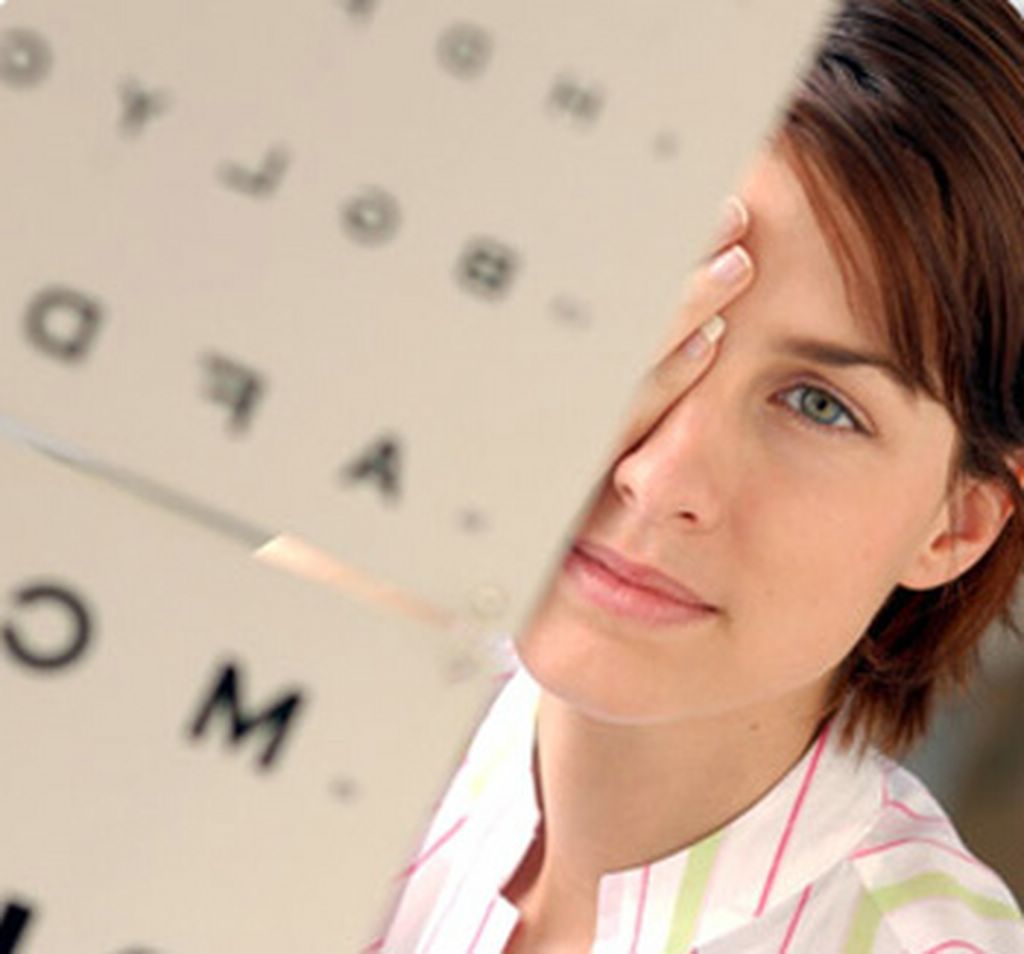
Similar to Sivtsev's method, the oculist table for eye examination with the Golovin method on the right side contains the data of indicator V. Each line corresponds to a specific value from 0.1 to 2.0. It is considered normal if a person correctly recognizes 10 lines from a distance of 5 meters. To calculate the size of the rings, it is necessary to divide 7 mm by the corresponding figure V. If the patient does not see the optotypes of the top line from a given distance, then the gap is reduced by 0.5 meters until the moment he calls the signs correctly.
If the interval for the study is reduced, then the following formula is used for the calculation: V = d / D, where V is the indicator of visual acuity; d is the distance used for diagnostics; D is the distance at which the normal eye recognizes the optotypes of this line. Also, special lenses and devices can be used to evaluate performance. Ophthalmologists often resort to using the Golovin table to rule out the fact that the patient learned the letters and their position on Sivtsev's poster.
Other diagnostic methods
Often parents are interested in the question of how to check their eyesight in childhood, if the child does not yet know the alphabet. In this case, the functioning of the organs of the visual system will be checked by the Orlova method. The Orlova table for eye examination in children consists of pictures and Landolg rings. The size of optotypes is calculated by the formula of a similar table Golovin. Eye examination in children is different. The doctor needs to evaluate whether the child understood what the pictures should be called. First show a table for checking near vision and asking to say what he sees. Further diagnosis is carried out similarly to other methods.

Also in ophthalmology, a test is used to check the vision and irregularities in the central field using the Amsler method. After 45 years, this type of diagnosis is recommended to take place regularly. For the survey used mesh Amsler or lattice Amsler. The principle of testing is that the subject should look at the grid consisting of squares and a point in the middle. The second eye when checking the method of Amsler should be closed.
The patient focuses the eye at a distance of 40-50 cm, if imaginary defects appear, an urgent examination by an ophthalmologist is necessary. Using the Amsler method, you can perform a vision check at home using a grid printed on the printer.
Rabkin's polychromatic tables are used to diagnose color blindness and its manifestations. There are 3 degrees of color perception: trichromates (norm), protanopes (deviation of the vision of the red spectrum) and deuteranopes (violation of the perception of the green color). For the diagnosis using color cards, which depict numbers and geometric shapes, their total number is 27 pieces. To determine violations in color perception, the cards are alternately shown to the patient. Depending on what the person sees on the cards, the ophthalmologist determines if he has color blindness.
The number of patients diagnosed with myopia is growing annually. The constant use of the TV, computer, tablet and other devices increases the strain on the eyes, causing a decrease in visual acuity. Elderly people, on the contrary, develop hyperopia, which also leads to certain limitations. If there are signs of irregularities, you need to consult a doctor and check your eyesight. In childhood this is especially important. Poor eyesight can lead to impairment of study, for example, because the child does not see what is written on the school board.
What if you have vision problems? Or did you start doing exercises for the eyes and want to monitor progress? In these and other cases, it is convenient to conduct a visual acuity check using a computer. For this, for example, you can use an online table named after the Soviet ophthalmologist D. A. Sivtsev. You must have seen her more than once in the office of an oculist. This is the most popular tool for diagnosing visual acuity.
This table has 12 rows of letters that vary in size.The first row of the letters "Ш Б" - a person with one hundred percent vision should see from a distance of 50 meters. The 10th row of the letters “N c and b m w s b”, distinguished by the patient from 5 meters, indicates the presence of a vision of 1.0. This vision is called 100%.
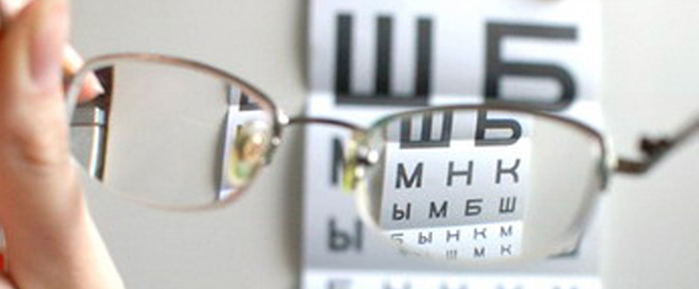
Sivtsev's table for eye examination at home, as well as the printed version, includes 12 lines of capital letters, the size of which decreases in a certain pattern from top to bottom. The value of D is marked on the left side of each line. It indicates the distance in meters from which a person with good eyesight should clearly recognize all the letters in the table. The value of V is indicated on the right. It is a conventional unit that indicates visual acuity. It is considered normal if a person sees the tenth row V = 1.0 from a distance of 5 meters (respectively, D = 5.0). It should be noted that only 7 letters are used in the table (M, K, H, W, S, I, B). With normal refraction, the point of clear vision is located at infinity, which for the human eye begins exactly at a distance of 5 meters. Therefore, the diagnosis of visual acuity is carried out at such a distance from the table itself.

How to check eyesight
Click on the image of the table to test Sivtsev’s vision so that it is available to you in full size, then move away from the computer monitor 5 meters away, close your right eye with your palm, but do not press it too hard. Try to read all the lines from top to bottom. Then do the same exercise with the left eye. In both cases, you need to define a row of the table, the letters in which you can easily distinguish. To the right of this line you will find a number (for example, V = 0.9), which will denote visual acuity for each eye. It should be noted that sometimes the results of checking the table are attempted to be converted to a percentage. However, this is not entirely correct. So, we can say that if V = 1.0, then we are talking about 100% vision. However, when V = 0.2, the sharpness is not 20%. It is equal to 49% of the normal value. Therefore, in percents, one can express only the ideal visual acuity at V = 1.0.
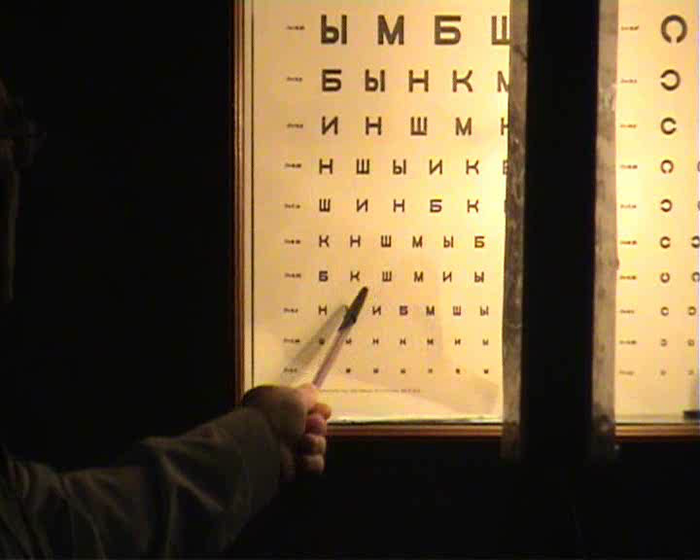
Rates and deviations
Record your vision test results on a sheet of paper, and then compare them with the letters in the table. Normally, a person is able to recognize characters on the 10th line from a distance of 5 meters. In this case, the severity is taken as a conventional unit of 1.0. The last, 12 row of the table, with normal vision, is recognized from a distance of 2.5 meters. In other cases, there are such disorders as hyperopia or myopia. In medical practice, there are people with telescopic vision (V\u003e 2). They can even distinguish between Saturn's rings and inscriptions on distant traffic signs. In addition, there is the concept and microscopic vision. It allows you to see very small objects without special optical devices.
If the vision check on the Sivtsev table online showed a deviation, you can take a duohromny test. With it, you can determine what kind of refractive disorder you develop: hyperopia or nearsightedness. More accurate results regarding visual acuity can be obtained by a personal visit to an ophthalmologist.

Self-assessment of visual acuity is inaccurate. And only a survey in the eye center can be a guarantee of accurate visual acuity!
“Close your right eye, now your left eye. Read the letters that I show. ” In front of the patient is a poster with the letters of the Russian alphabet drawn in black paint. Probably for most people this test seems funny, especially in childhood. However, an eye test on the ophthalmologic table is a very simple, painless, but at the same time very effective test that allows you to diagnose vision problems in a timely manner.
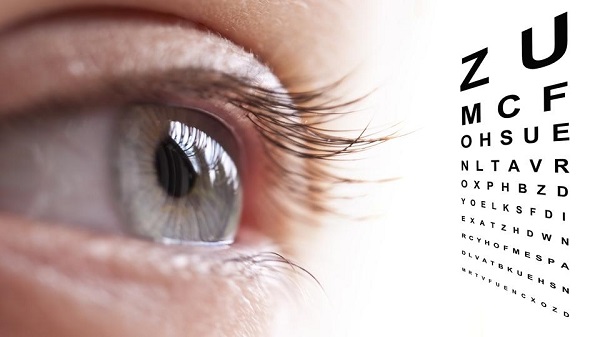
Sivtsev's table - this is exactly the name of the poster with the letters that is in every ophthalmologic office in Russia and the CIS countries. It is named for the ophthalmologist Dmitry Alexandrovich Sivtsev.
The test table, as is known, is a set of printing characters - letters. There are seven of them: B, I, K, M, N, Y, S. They are written in twelve lines. From the top line to the bottom of the letter are reduced.
To the left of the lines is indicated “visus” - the value corresponding to visual acuity. It is denoted by the Latin letter V and is expressed in arbitrary units. So, the row at the very top corresponds to the indicator of 0.1, the bottom one - 2.0.
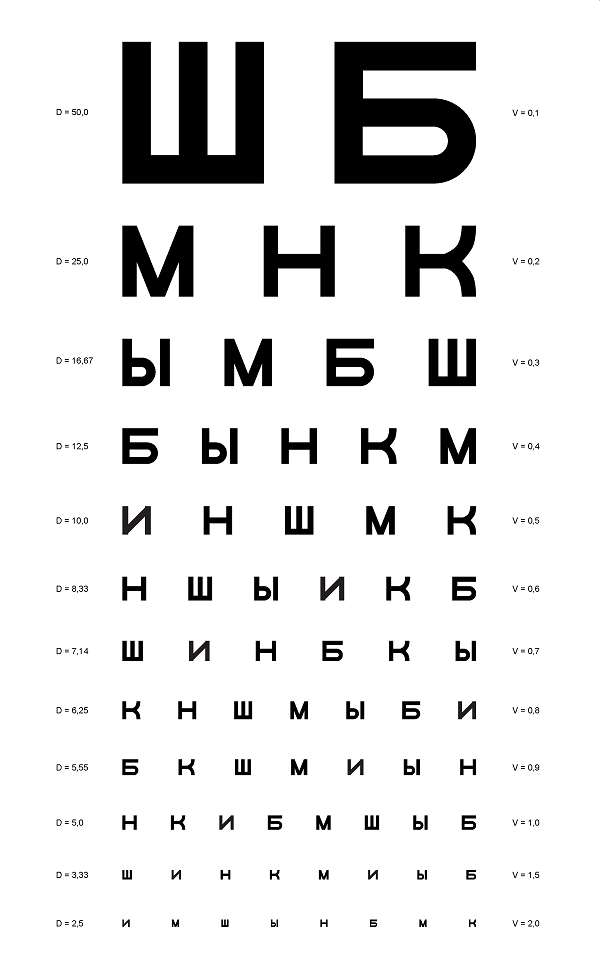
It is considered a norm if a person from five meters reads written in the tenth line
A norm is considered if a person from five meters reads written in the tenth line. Then V = 1.0 (corresponds to 100% of the view). Scientists have found that such a person visually separates adjacent points when the angular distance between them is 1/60 of a degree, or 1 arc minute. At a distance of 5 m it is 1.45 mm. This distance separates two adjacent vertical segments in the letter W from the tenth row.
How is the test?
A study conducted using the Sivtsev table is called a visometry. The test fabric is illuminated by two fluorescent (daylight) lamps so that the illumination is 700 lux. The bottom edge of the illuminator is at a height of 120 cm from the floor surface.
Check the eyes alternately, first right, then left. The test eye is open, the other is covered with a special flap, but the eyelids of both eyes are open, the head is held strictly straight. Lines after the tenth are intended for people with a visual indicator of 150 and 200%. Also, these lines can be used when the cabinet length is not enough to conduct a study from 5 m. Corresponding amendments are made to the calculations.
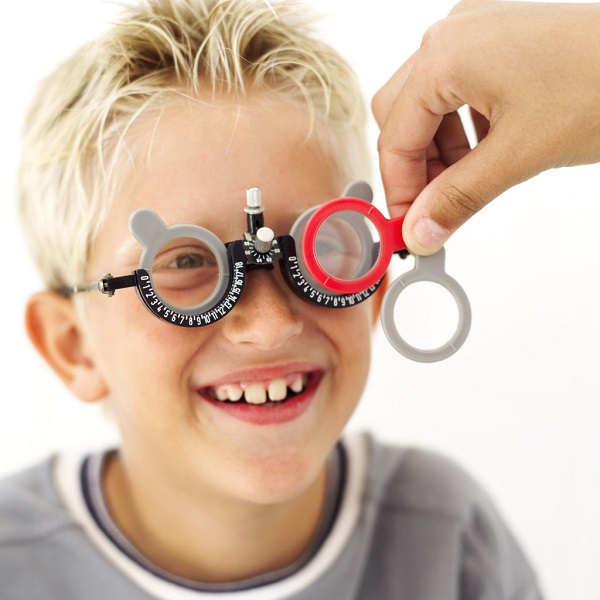
Check the eyes alternately, first right, then left.
Visometry is performed in the following order. The doctor indicates the sign for 2–3 seconds and asks the patient to name it. Checks for adults usually begin with the bottom lines, where the smallest characters, gradually moving to the top.
Visual acuity is defined as:
- complete, when a person correctly named all the letters in the row without exception;
- incomplete (in the corresponding series), when mistakes are made, while their number is limited:
When the result is lower than 1.0, they talk about myopia (myopia), and higher than 1.0 - about hyperopia (hyperopia).
Normal vision is called emmetropia. The point of clear vision for such a person is located, as it were, in infinity, and infinity is 5 m and more. If you place the object at a shorter distance, then parallel rays are collected on the retina. For this reason, 5 m is considered optimal for visometry.
If a person is not able to read what is written in the uppermost row, they are asked to approach the table by half a meter. They do this until the person being checked correctly names all the letters or most of them. Then visual acuity is calculated using a special formula: V = d / D. Here, d is taken as the distance from which the test is performed, and D is the distance from which the line is seen in normal vision (100%, or 1.0) (this is a constant it is indicated to the left of the rows, its indicators - from 50 to 2.5). So, if the formula multiplies the standard for such a test of 5 m per vizus index of 0.1 of the first line, then it turns out that a person can see the largest figures in the table from a distance of 50 m, the last one from 2.5 m. sees the signs of the first row, prefer the optotypes of the Pole.
Simultaneously with Sivtsev's table, a table is usually used, named after another ophthalmologist, Sergey Selivanovich Golovin. He composed her of Landolt rings (rings broken on one side), arranged in twelve lines.
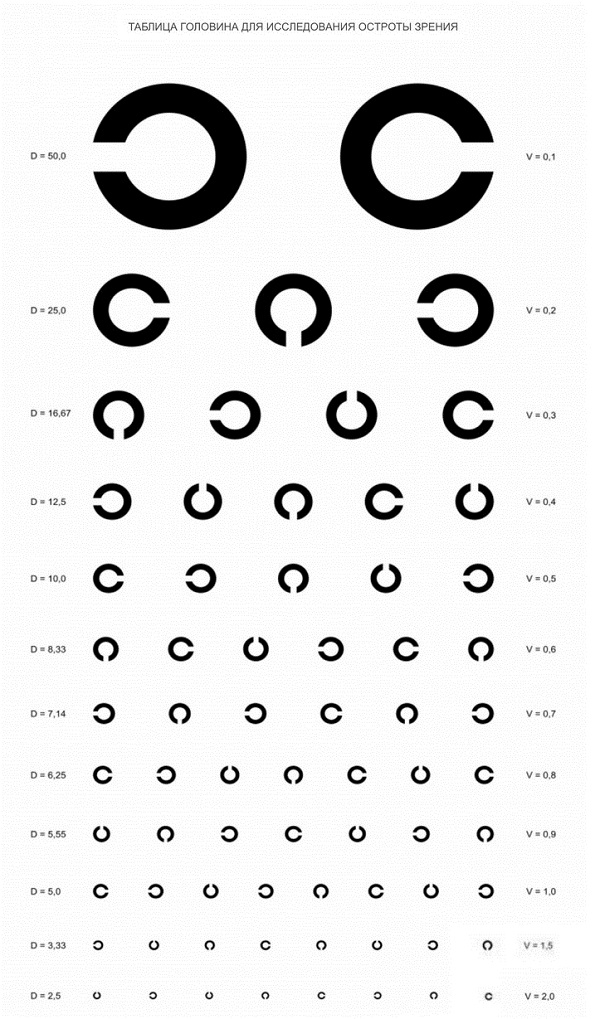
The size of the rings is determined as follows: 7 mm divided by the value of V (the same indicators as in the Golovin table) corresponding to this row. As a result, the first line contains rings of 70 mm, on the bottom - 3.5 mm.
The principle of determining the indicator is similar to the previous one.
How to check the sight of children
Not all preschool children know the alphabet, so the Orlova or Aleinikova tables are used for them. The standard 12 lines consist of pictures, not letters, and several Landolt rings. The size of the figures is determined by the same formula as the size of the Landolt rings for the Golovin table.
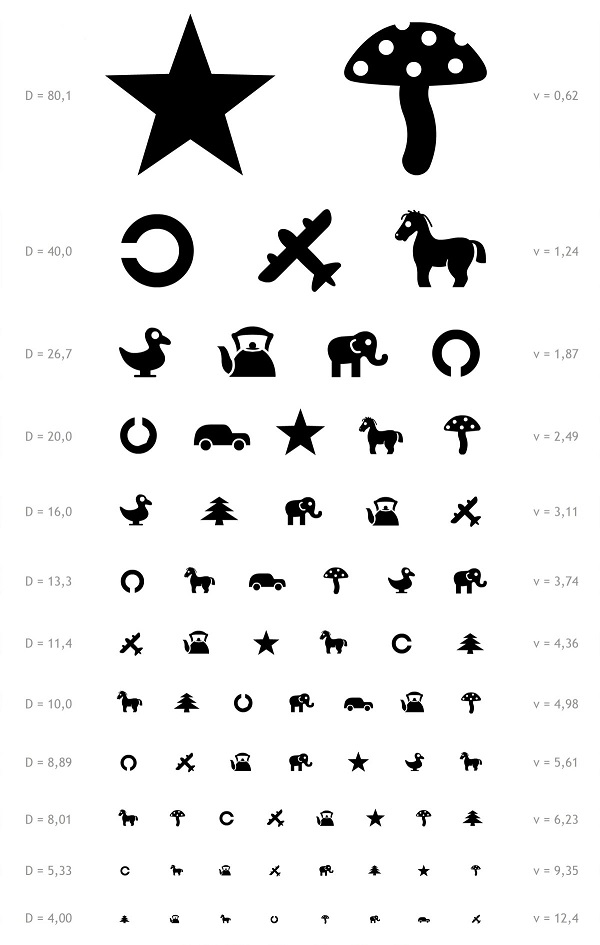
Inspection of the child has its own characteristics. For a more reliable result, the doctor, before starting the procedure, should explain to the child what they want from him and make sure that the child is able to name the depicted figures. To do this, they bring him to the test canvas and ask him to say what he sees there.
Children get tired very quickly, so the optometrist begins to show the largest pictures, only one of each row. Only when the child is unable to give the correct answer, he is shown the remaining characters from the same series.
Pole Optotypes
They are used to determine from what distance a person can read the characters of the first row, that is, when his visual acuity is lower than 0.1.
These optotypes are a set of circular and trilinear signs. They are designed so that by the thickness of the lines and the width of the gaps it is possible to determine the visual acuity in the range from 0.04 to 0.09. The study is conducted with a standard 5 m.
This table is considered the most common in the world. It traditionally received its name from the ophthalmologist who created it in 1862 - the Dutchman Hermann Snellen. It consists of capital Latin letters-optotypes, which are reduced from one line to another.
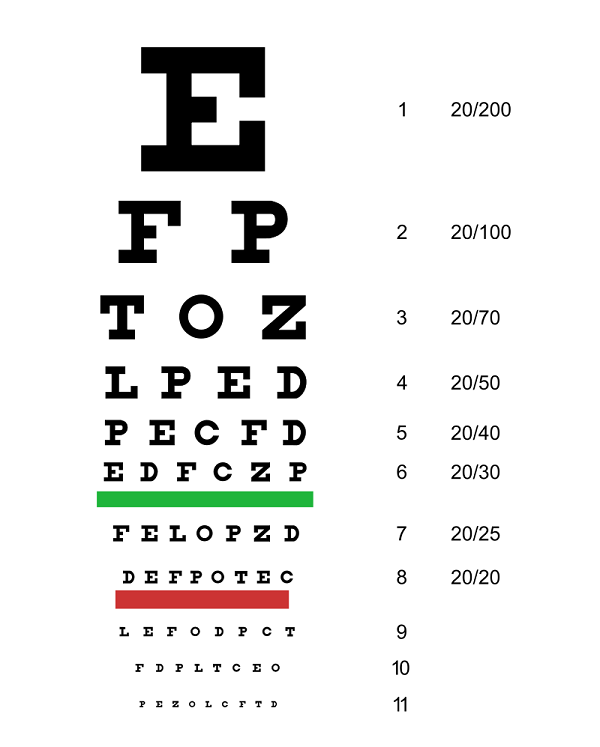
The largest optotypes are at the top. A person, having 100% of sight, freely recognizes signs in 1–8 rows. The maximum distance from which the top row is visible is 60 m, the last one is from 5 m. The distance between a table and a person is 6 meters.
How to do visometry yourself?
You can make the Sivtsev table yourself, so that if you have any doubts, check your eyesight. This will require three white matte sheets of A4 paper, a laser printer, a black marker, felt-tip pen or ink, as well as adhesive tape, glue.
Here is a guide to create it.
- It is necessary to download files located (files are attached in PDF format) and print them on paper. It is important to ensure that the scale was 100%. For a more accurate result, the paper should be pure white, without a yellowish tint.
- It often happens that the printer does not give a uniform black color. Then a black marker or mascara will come in handy: they let the characters down to increase the contrast.
- To connect the printed sheets using glue or tape.
- The finished table is attached to a wall or other vertical surface — it could be a door, a cabinet surface, and the like. Height must be calculated so that the tenth row is exactly at eye level.
To check if there are any distortions in the printout, it is enough to measure the letters. They are inscribed in a square with a side of 70 m - for the first row, 35 mm - for the second, 7 mm - for the tenth.
The result is affected by the degree of illumination of the room depending on the time of day and weather. For uniform illumination using a table lamp with a power of 40 W, the rays of which are directed to the table.
Measuring visual acuity, do not worry if some day the result will be worse. This happens after stress or grueling work. In order for everything to return to normal, you need to have a good enough rest or calm down.
Devices are replacing
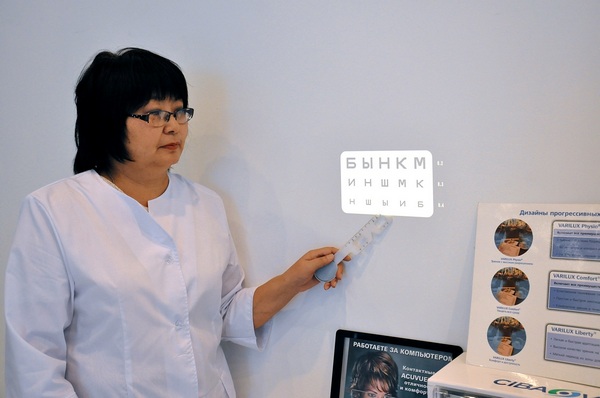
Recently, replacing the tables come transparency devices. The test mark is depicted not on paper, but on milk glass. Behind the glass is a light source. Oculists use in their work and collimator method. Then the letter or sign is close, but thanks to the optical instruments they are seen in infinity. In clinics, you can now see special projectors, the feature of which is good illumination and clear, high-contrast image transmission.
Video - T table types for vision testing and its improvement
- In contact with 0
- Google+ 0
- OK 0
- Facebook 0

